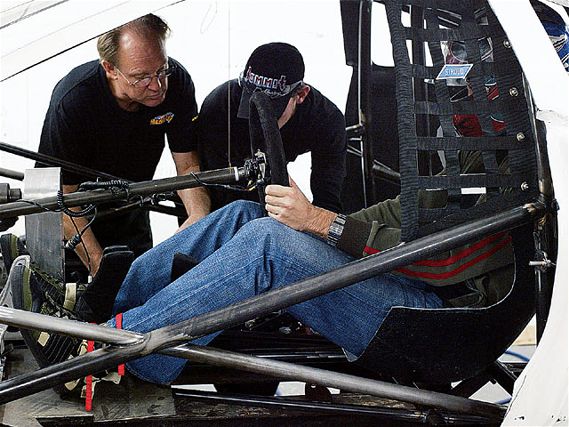 | HANS - The Safety Factor - Terminal Velocity
| HANS - The Safety Factor - Terminal Velocity
As a racecar designer and constructor, the most important part of my job is to make sure the driver is as safe as possible when he's putting the car through its paces.
Most of the sanctioning bodies in all kinds of racing strictly regulate the construction of the cars and the safety equipment the drivers use. This is good: Let's face it, the sad reality is that people die in our sport and anything you can do to prevent this from happening has to be a good thing.
I'm still amazed when I see so-called "professional" racers wearing open-face helmets. I know they'll come up with many excuses as to why they don't want to wear a full-face helmet: "It's too heavy," "It restricts my vision," or "It's uncomfortable." The fact is, today's helmets are lighter, stronger and better designed than ever. An open-face helmet that was designed when Don Garlitz was a novice drag-racer is never going to offer the same amount of protection as a properly fitted full-face design. Thinking of racing? Get smart and invest in the best possible helmet you can afford.
The same thing goes for head-and-neck restraint devices (HANS). It's been proven that HANS devices save lives. They're mandatory in F1 and NASCAR and the reason that these and many other sanctioning bodies are enforcing the use of HANS devices is they save lives, pure and simple. A HANS device is affordable these days and, once again, it's simply a case of spending money to eliminate as many of the risk factors as possible.
The same rules apply to your car. Why take chances by skimping? Apart from the obvious things like tire condition and structural safety, there are many areas where you can make your vehicle a safer competition environment, simple things like the position of gauges, parachute release and fire extinguisher system activation. These things should be positioned so the driver can operate them easily. Gauges can be rotated so the indicators all point straight-up under normal operating conditions; that way, a brief glance at the gauges will tell you if everything is OK. If one of the gauges is off either way, you'll know instantly without the distraction of mentally processing information from different gauges.
Make a checklist and use it. I have been racing for more than 40 years and I still have a checklist to make sure I don't forget the obvious things that need maintenance between races. The simple stuff like lug-nut torque and checking the tightness of nuts and bolts is easily forgotten in the heat of competition. Get used to a routine and stick to it.
I'm pleased to see that real bead-lock rims are starting to appear in drag racing. They may weigh a little more than a normal design, but the safety benefits heavily outweigh the weight difference. Any driver who has had a tire separate from the rim at high speed will tell you that it's not one of life's more pleasant experiences. The sooner these wheels become widely available, the better.
Over the next few years, I'm sure we'll see many more innovations in racecar safety. Modern technology is making the search for a safe racing environment more thorough, but danger will always be a factor. That is also the appeal of pushing the limits and competing in a racecar. The adrenaline rush from teetering on the brink of disaster is addictive but, at the same time, a little thought in advance can save your life and keep you out there having fun for as long as you want to.
So, get a decent helmet, wear an approved fire-resistant suit and Nomex underwear (I don't know about you, but I consider the contents of my underwear to be precious.), invest in a HANS device and spend the time to ensure your car is in tip-top condition.
Most of the things I've mentioned are simple common sense. For a few-hundred bucks and a little time you can significantly increase your chances of walking away from a potentially bad situation.
Be safe and I will see you at the next race.
